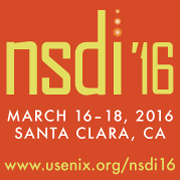BeamSpy: Enabling Robust 60 GHz Links Under Blockage
Sanjib Sur, Xinyu Zhang, and Parmesh Ramanathan, University of Wisconsin—Madison; Ranveer Chandra, Microsoft Research
Due to high directionality and small wavelengths, 60 GHz links are highly vulnerable to human blockage. To overcome blockage, 60 GHz radios can use a phased-array antenna to search for and switch to unblocked beam directions. However, these techniques are reactive, and only trigger after the blockage has occurred, and hence, they take time to recover the link. In this paper, we propose BeamSpy, that can instantaneously predict the quality of 60 GHz beams, even under blockage, without the costly beam searching. BeamSpy captures unique spatial and blockage-invariant correlation among beams through a novel prediction model, exploiting which we can immediately select the best alternative beam direction whenever the current beam’s quality degrades. We apply BeamSpy to a run-time fast beam adaptation protocol, and a blockage-risk assessment scheme that can guide blockage-resilient link deployment. Our experiments on a reconfigurable 60 GHz platform demonstrate the effectiveness of BeamSpy's prediction framework, and its usefulness in enabling robust 60 GHz links.
Open Access Media
USENIX is committed to Open Access to the research presented at our events. Papers and proceedings are freely available to everyone once the event begins. Any video, audio, and/or slides that are posted after the event are also free and open to everyone. Support USENIX and our commitment to Open Access.
author = {Sanjib Sur and Xinyu Zhang and Parmesh Ramanathan and Ranveer Chandra},
title = {{BeamSpy}: Enabling Robust 60 {GHz} Links Under Blockage},
booktitle = {13th USENIX Symposium on Networked Systems Design and Implementation (NSDI 16)},
year = {2016},
address = {Santa Clara, CA},
pages = {193--206},
url = {https://www.usenix.org/conference/nsdi16/technical-sessions/presentation/sur},
publisher = {USENIX Association},
month = mar
}















connect with us